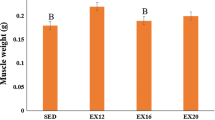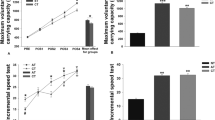Abstract
The purpose of this study is to investigate the effects of non-weight-bearing exercise on growing bone. Male Wistar rats (7 week-old) were assigned to one baseline control group, one control group and two swimming training groups, which were trained with 2 and 4% body-weight mass added, respectively. After an 8-week training period, three groups showed significant development compared to the baseline control group. Among the three 15-week-old groups, swimming-trained rats were lower in body weight (BW), densitometry and size-related measurements. In femoral biomechanical testing, swimming training groups were significantly lower in yield moment and ultimate moment, which may be due to a significantly lower long bone cross-sectional moment of inertia. However, the two swimming groups were higher in post-yield energy absorption and displacement. Further, in estimated tissue-level biomaterial properties, no differences were shown in yield stress, strain or toughness among the three groups. Using BW as a covariate, results of ANCOVA showed no differences in size-related parameters among the three groups, and some parameters were even higher in the two swimming groups. Regarding Pearson’s correlation, size-related parameters correlated well to BW and whole bone strength but not to tissue post-yield behaviors. In conclusion, when compared to age-matched control group, swimming rats showed lower bone strength and lower yield energy absolutely at the structural level, but similar yield stress and yield toughness at the tissue level. Moreover, swimming training benefited growing bone in post-yield behaviors. Further studies should investigate the parameters that contribute to this exercise-induced post-yield behavior.
Similar content being viewed by others
Notes
Part of the raw data (the LOW group and the CON group) in the present study shared the raw data of our previous work [10, 21]. Briefly, some of the animals (10 of 14) in the LOW group were the same as the SWIM group in one of our previous studies [10]. Additionally, the current study shared the same control group with our previous publications [10, 21]. All of the exercise-training regimes were done in the same time periods, while focusing on different topics.
References
Gustavsson A, Thorsen K, Nordstrom P (2003) A 3-year longitudinal study of the effect of physical activity on the accrual of bone mineral density in healthy adolescent males. Calcif Tissue Int 73:108–114
Hind K, Burrows M (2007) Weight-bearing exercise and bone mineral accrual in children and adolescents: a review of controlled trials. Bone 40:14–27
Magkos F, Kavouras SA, Yannakoulia M, Karipidou M, Sidossi S, Sidossis LS (2007) The bone response to non-weight-bearing exercise is sport-, site-, and sex-specific. Clin J Sport Med 17:123–128
Suominen H (1993) Bone mineral density and long term exercise. An overview of cross-sectional athlete studies. Sports Med 16:316–330
Cummings SR, Bates D, Black DM (2002) Clinical use of bone densitometry—scientific review. JAMA 288:1889–1897
Skedros JG, Dayton MR, Sybrowsky CL, Bloebaum RD, Bachus KN (2006) The influence of collagen fiber orientation and other histocompositional characteristics on the mechanical properties of equine cortical bone. J Exp Biol 209:3025–3042
Burr DB (2002) The contribution of the organic matrix to bone’s material properties. Bone 31:8–11
Warner SE, Shea JE, Miller SC, Shaw JM (2006) Adaptations in cortical and trabecular bone in response to mechanical ming with and without weight bearing. Calcif Tissue Int 79:395–403
Gomes RJ, de Mello MA, Caetano FH, Sibuya CY, Anaruma CA, Rogatto GP, Pauli JR, Luciano E (2006) Effects of swimming training on bone mass and the GH/IGF-1 axis in diabetic rats. Growth Horm IGF Res 16:326–331
Huang TH, Lin SC, Chang FL, Hsieh SS, Liu SH, Yang RS (2003) Effects of different exercise modes on mineralization, structure, and biomechanical properties of growing bone. J Appl Physiol 95:300–307
Hart KJ, Shaw JM, Vajda E, Hegsted M, Miller SC (2001) Swim-trained rats have greater bone mass, density, strength, and dynamics. J Appl Physiol 91:1663–1668
Nyska M, Nyska A, Swissa-Sivan A, Samueloff S (1995) Histomorphometry of long bone growth plate in swimming rats. Int J Exp Pathol 76:241–245
Swissa-Sivan A, Azoury R, Statter M, Leichter I, Nyska A, Nyska M, Menczel J, Samueloff S (1990) The effect of swimming on bone modeling and composition in young adult rats. Calcif Tissue Int 47:173–177
Simkin A, Leichter I, Swissa A, Samueloff S (1989) The effect of swimming activity on bone architecture in growing rats. J Biomech 22:845–851
Snyder A, Zierath JR, Hawley JA, Sleeper MD, Craig BW (1992) The effects of exercise mode, swimming vs. running, upon bone growth in the rapidly growing female rat. Mech Ageing Dev 66:59–69
Honda A, Umemura Y, Nagasawa S (2001) Effect of high-impact and low-repetition training on bones in ovariectomized rats. J Bone Miner Res 16:1688–1693
Huang TH, Yang RS, Hsieh SS, Liu SH (2002) Effects of caffeine and exercise on the development of bone: a densitometric and histomorphometric study in young Wistar rats. Bone 30:293–299
Huang TH, Muhlbauer RC, Tang CH, Chen HI, Chang GL, Huang YW, Lai YT, Lin HS, Yang WT, Yang RS (2008) Onion decreases the ovariectomy-induced osteopenia in young adult rats. Bone 42:1154–1163
Parfitt AM, Mathews CH, Villanueva AR, Kleerekoper M, Frame B, Rao DS (1983) Relationships between surface, volume, and thickness of iliac trabecular bone in aging and in osteoporosis. Implications for the microanatomic and cellular mechanisms of bone loss. J Clin Invest 72:1396–1409
Brodt MD, Ellis CB, Silva MJ (1999) Growing C57Bl/6 mice increase whole bone mechanical properties by increasing geometric and material properties. J Bone Miner Res 14:2159–2166
Huang TH, Chang FL, Lin SC, Liu SH, Hsieh SS, Yang RS (2008) Endurance treadmill running training benefits the biomaterial quality of bone in growing male Wistar rats. J Bone Miner Metab 26:350–357
Turner CH, Burr DB (1993) Basic biomechanical measurements of bone—a tutorial. Bone 14:595–608
Voide R, van Lenthe GH, Muller R (2008) Bone morphometry strongly predicts cortical bone stiffness and strength, but not toughness, in inbred mouse models of high and low bone mass. J Bone Miner Res 23:1194–1203
Currey JD (1988) The effect of porosity and mineral content on the Young’s modulus of elasticity of compact bone. J Biomech 21:131–139
Currey JD (1979) Changes in the impact energy absorption of bone with age. J Biomech 12:459–469
Boskey AL, Wright TM, Blank RD (1999) Collagen and bone strength. J Bone Miner Res 14:330–335
Wang X, Bank RA, TeKoppele JM, Agrawal CM (2001) The role of collagen in determining bone mechanical properties. J Orthop Res 19:1021–1026
Zioupos P, Currey JD (1998) Changes in the stiffness, strength, and toughness of human cortical bone with age. Bone 22:57–66
Puustjarvi K, Nieminen J, Rasanen T, Hyttinen M, Helminen HJ, Kroger H, Huuskonen J, Alhava E, Kovanen V (1999) Do more highly organized collagen fibrils increase bone mechanical strength in loss of mineral density after one-year running training? J Bone Miner Res 14:321–329
Augat P, Schorlemmer S (2006) The role of cortical bone and its microstructure in bone strength. Age Ageing 35(Suppl 2):ii27–ii31
Wallace JM, Rajachar RM, Allen MR, Bloomfield SA, Robey PG, Young MF, Kohn DH (2007) Exercise-induced changes in the cortical bone of growing mice are bone- and gender-specific. Bone 40:1120–1127
Wallace JM, Ron MS, Kohn DH (2009) Short-term exercise in mice increases tibial post-yield mechanical properties while two weeks of latency following exercise increases tissue-level strength. Calcif Tissue Int 84:297–304
Frost HM (1987) Bone “mass” and the “mechanostat”: a proposal. Anat Rec 219:1–9
Rico H, Revilla M, Hernandez ER, Villa LF, Alvarez del Buergo M, Lopez Alonso A (1991) Age- and weight-related changes in total body bone mineral in men. Miner Electrolyte Metab 17:321–323
Siemon NJ, Moodie EW (1973) Body weight as a criterion in judging bone mineral adequacy. Nature 243:541–543
Jurimae T, Soot T, Jurimae J (2005) Relationships of anthropometrical parameters and body composition with bone mineral content or density in young women with different levels of physical activity. J Physiol Anthropol Appl Human Sci 24:579–587
Yirmiya R, Goshen I, Bajayo A, Kreisel T, Feldman S, Tam J, Trembovler V, Csernus V, Shohami E, Bab I (2006) Depression induces bone loss through stimulation of the sympathetic nervous system. Proc Natl Acad Sci USA 103:16876–16881
Porsolt RD, Le Pichon M, Jalfre M (1977) Depression: a new animal model sensitive to antidepressant treatments. Nature 266:730–732
Linthorst AC, Flachskamm C, Reul JM (2008) Water temperature determines neurochemical and behavioural responses to forced swim stress: an in vivo microdialysis and biotelemetry study in rats. Stress 11:88–100
Walsh NP, Blannin AK, Clark AM, Cook L, Robson PJ, Gleeson M (1998) The effects of high-intensity intermittent exercise on the plasma concentrations of glutamine and organic acids. Eur J Appl Physiol Occup Physiol 77:434–438
Walsh NP, Blannin AK, Robson PJ, Gleeson M (1998) Glutamine, exercise and immune function. Links and possible mechanisms. Sports Med 26:177–191
Sellers TL, Jaussi AW, Yang HT, Heninger RW, Winder WW (1988) Effect of the exercise-induced increase in glucocorticoids on endurance in the rat. J Appl Physiol 65:173–178
Cortright RN, Chandler MP, Lemon PW, DiCarlo SE (1997) Daily exercise reduces fat, protein and body mass in male but not female rats. Physiol Behav 62:105–111
Dohm GL, Louis TM (1978) Changes in androstenedione, testosterone and protein metabolism as a result of exercise. Proc Soc Exp Biol Med 158:622–625
Hackney AC (1996) The male reproductive system and endurance exercise. Med Sci Sports Exerc 28:180–189
Herrmann M, Muller M, Scharhag J, Sand-Hill M, Kindermann W, Herrmann W (2007) The effect of endurance exercise-induced lactacidosis on biochemical markers of bone turnover. Clin Chem Lab Med 45:1381–1389
Aoi W, Iwashita S, Fujie M, Suzuki M (2004) Sustained swimming increases erythrocyte MCT1 during erythropoiesis and ability to regulate pH homeostasis in rat. Int J Sports Med 25:339–344
Brahm H, Strom H, Piehl-Aulin K, Mallmin H, Ljunghall S (1997) Bone metabolism in endurance trained athletes: a comparison to population-based controls based on DXA, SXA, quantitative ultrasound, and biochemical markers. Calcif Tissue Int 61:448–454
Maimoun L, Galy O, Manetta J, Coste O, Peruchon E, Micallef JP, Mariano-Goulart D, Couret I, Sultan C, Rossi M (2004) Competitive season of triathlon does not alter bone metabolism and bone mineral status in male triathletes. Int J Sports Med 25:230–234
Acknowledgements
This study was supported by a grant from the National Science Council (NSC-89-2314-B-002-380, TAIWAN). Jae Cody is appreciated for her editorial assistance.
Author information
Authors and Affiliations
Corresponding author
Rights and permissions
About this article
Cite this article
Huang, TH., Hsieh, S.S., Liu, SH. et al. Swimming Training Increases the Post-Yield Energy of Bone in Young Male Rats. Calcif Tissue Int 86, 142–153 (2010). https://doi.org/10.1007/s00223-009-9320-0
Received:
Accepted:
Published:
Issue Date:
DOI: https://doi.org/10.1007/s00223-009-9320-0




